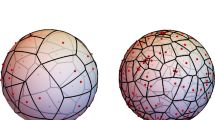Abstract
We consider the discrete Voronoi diagram in the three-dimensional space, that is, the Voronoi tessellation of a 3-D binary image. The input to the tessellation algorithm is a 3-D image containing a set of pixels of value 0 (generators). The goal is to classify the rest of the pixels to the nearest generator. This paper gives a simple algorithm for computing the Voronoi tessellation map of a 3-D binary image. It runs in O(N3) time for anN ×N ×N input image. A hardware algorithm is also presented, which computes the 3-D Voronoi tessellation map in O(N2) time on an O(N3)-cell array.
Similar content being viewed by others
References
G. Borgefors, Distance transformations in digital images. Comput. Vision, Graphics, Image Proc,34 (1986), 344–371.
H. Breu, J. Gil, D. Kirkpatrick and M. Werman, Linear time Euclidean distance transform algorithms. IEEE Trans. on PAMI,17, No. 5 (1995), 529–533.
L. Chen and H.Y.H. Chuang, A fast algorithm for Euclidean distance maps of a 2-D binary image. Information Processing Letters,51 (1994), 25–29.
L. Chen and H.Y.H. Chuang, An efficient algorithm for complete Euclidean distance transform on mesh-connected SIMD. Parallel Comput.,21, No. 5 (1995), 841–852.
P.E. Danielsson, Euclidean distance mapping. Comput. Graphics and Image Proa,14 (1980), 227–248.
A. Fujiwara and T. Masuzawa, An optimal parallel algorithm for the Euclidean distance maps of 2-D binary images. Information Processing Letters,54 (1995), 295–300.
T. Hirata, A unified linear-time algorithm for computing distance maps. Information Processing Letters,58 (1996), 129–133.
M.N. Kolountzakis and K.N. Kutulakos, Fast computation of Euclidean distance maps for binary images. Information Processing Letters,43 (1992), 181–184.
Y. Lee and S. Horng and T. Kao and Y. Chen, Parallel computation of the Euclidean distance transform on the mesh of trees and the hypercube computer. CVGIP: Image Understanding,68 (1997), 109–119.
F. Leymarie and M.D. Levine, Fast raster scan distance propagation on the discrete rectangular lattice. CVGIP: Image Understanding,55 (1992), 84–94.
M. Miyazawa, P.F. Zeng, N. Iso and T. Hirata, A systolic algorithm for Euclidean distance transform. Technical Report of IPSJ, AL-87-8, 2002, 43–49, (in Japanese).
D.W. Paglieroni, A unified distance transformation algorithm and architecture. Machine Vision Appl.,5 (1992), 47–55.
I. Pitas, Performance analysis of morphological Voronoi tessellation algorithms. Advances in Digital and Computational Geometry (eds. R. Klette, A. Rosenfeld and F. Sloboda), Springer, 1998, 227–254.
H. Yamada, Complete Euclidean distance transformation by parallel operation. Proc. of 7th Int. Conf. on Pattern Recognition, 1984, 69–71.
Author information
Authors and Affiliations
Corresponding author
About this article
Cite this article
Hirata, T. 3-D Voronoi tessellation algorithms. Japan J. Indust. Appl. Math. 22, 223–231 (2005). https://doi.org/10.1007/BF03167439
Received:
Revised:
Issue Date:
DOI: https://doi.org/10.1007/BF03167439




